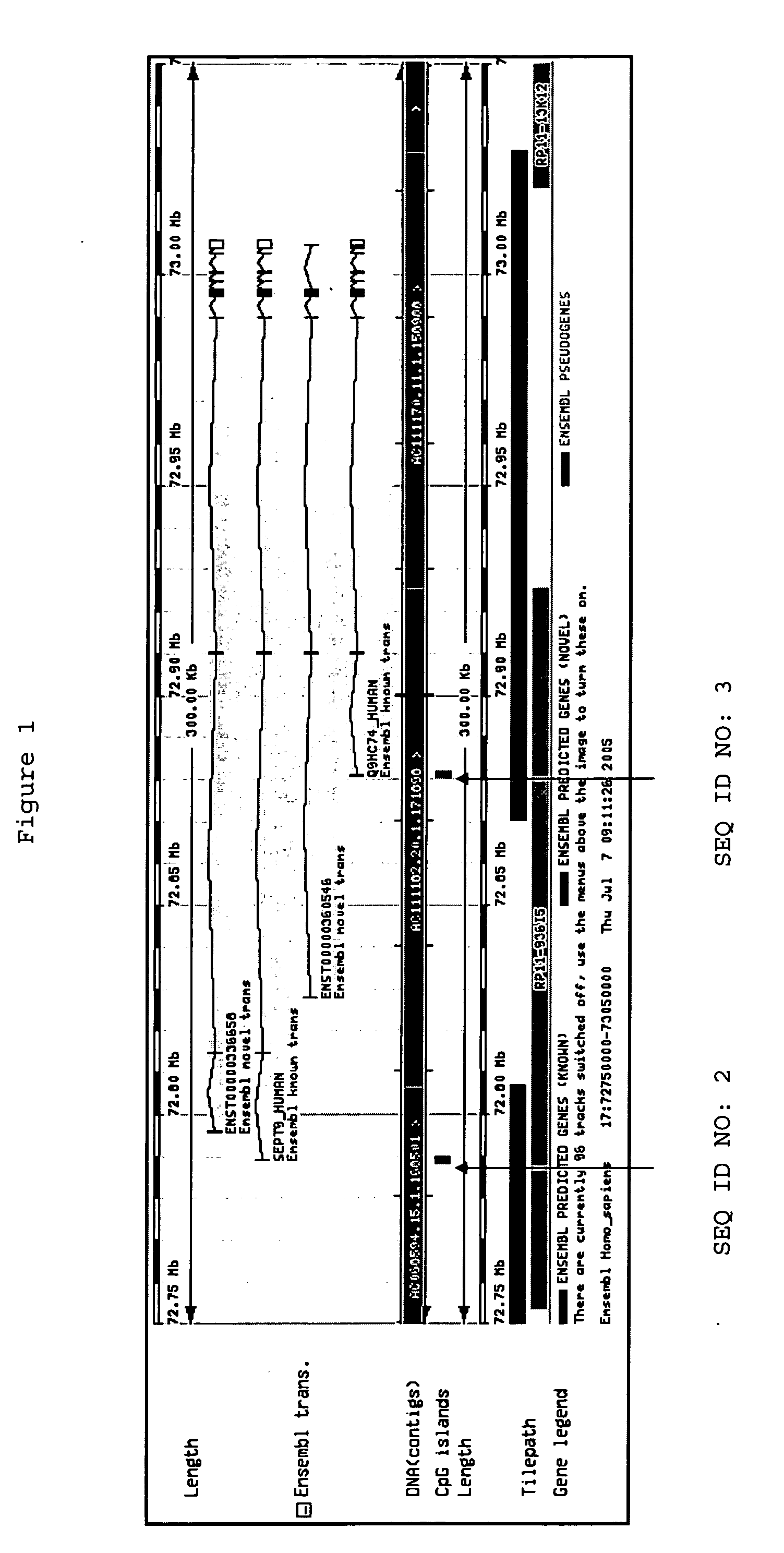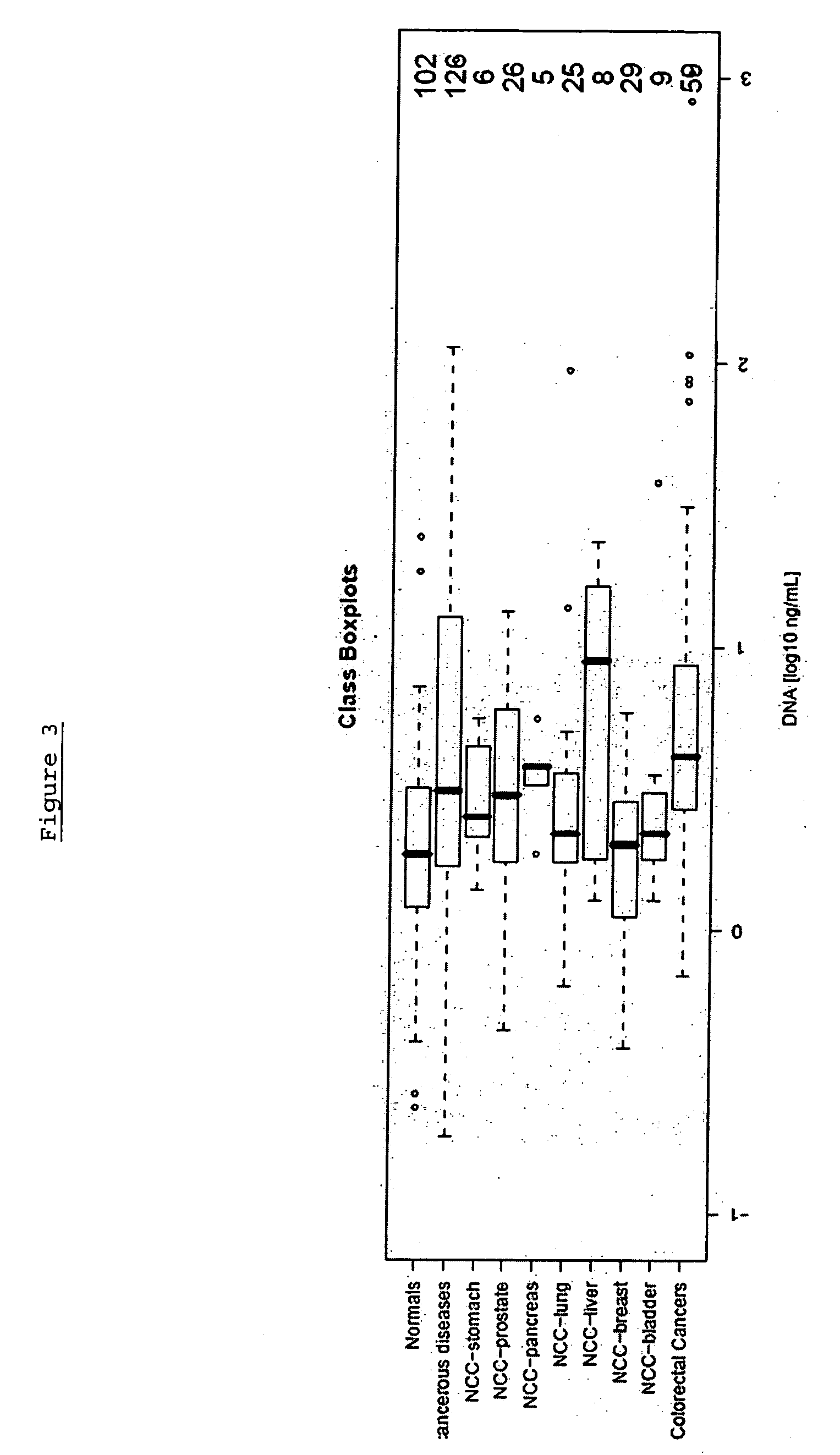Methods and nucleic acids for the analyses of cellular proliferative disorders
a proliferative disorder and analysis method technology, applied in the field of gene expression dna sequences, can solve the problems of ineffective implementation of colorectal cancer screening, insensitive to multi-focal small lesions and treatment planning, and high cost of current recommended methods for cancer diagnosis, etc., to achieve the effect of improving sensitivity, specificity and/or predictive value, and improving sensitivity and specificity and likely patient complian
- Summary
- Abstract
- Description
- Claims
- Application Information
AI Technical Summary
Benefits of technology
Problems solved by technology
Method used
Image
Examples
example 1
[0269] In the following example a variety of assays suitable for the methylation analysis of SEQ ID NO:1 were designed. The assays were designed to be run on the LightCycler™ platform (Roche Diagnostics), but other such instruments commonly used in the art are also suitable. The assays were MSP and HeavyMethyl assays. MSP amplificates were designed to be detected by means of Taqman™ style fluorescent labelled detection probes, HeavyMethyl™ amplificates were designed to be detected by means of LightCycler™ style dual probes.
Genomic Region of Interest:
[0270] SEQ ID NO:1
[0271] Assay type: MSP
Primers:aaaatcctctccaacacgtcSEQ ID NO:121cgcgattcgttgtttattagSEQ ID NO:122Taqman probes:cggatttcgcggttaacgcgtagttSEQ ID NO:123
Temperature Cycling Program: [0272] activation: 95° C. 10 min [0273] 55 cycles: 95° C. 15 sec (20 ° C. / s) [0274] 62° C. 45 sec (20° C. / s) [0275] cooling: 40° C. 5 sec
Genomic Region of Interest: [0276] SEQ ID NO:1
[0277] Assay type: MSP
Primers:aaaatcctctccaacacgtcS...
example 2
[0288] The following analysis was performed in order to select preferred panels suitable for colorectal carcinoma screening and / or diagnosis based on analysis of DNA methylation within whole blood, said panel comprising at least the analysis of SEQ ID NO: 1. The best performing assays from Example 1 were selected for the analyses, in addition to methylation assays suitable for analysis of the genes according to SEQ ID NOS:24 to SEQ ID NO:27 of Table 1.
[0289] The performance of each marker was analysed using an assay platform (LightCycler™) and real time assays (MSP and / or HeavyMethyl™) as would be suitable for use in a reference or clinical laboratory setting. The performance of each marker was tested independently in colorectal carcinoma tissue and whole blood, in order to provide an indication of the accuracy of each marker.
[0290] In addition to the analysis of SEQ ID NO:1 the panels comprised further genes selected from the group of markers consisting:
FOX2(SEQ ID NO:24)NGFR(S...
example 3
[0309] The following analysis was performed in order to confirm the gene Septin 9, (including its transcript variant Q9HC74) and panels thereof as a suitable marker for colorectal carcinoma screening and / or diagnosis based on analysis of DNA methylation in whole blood by validating the performance of assays in a large sample set.
[0310] The performance of the marker was analysed using an assay platform (Lightcycler) and real time assays (MSP and / or HeavyMethyl) as would be suitable for use in a reference or clinical laboratory setting. The performance of each marker was tested independently in colorectal tissue (normal adjacent tissue), colorectal carcinoma tissue and whole blood, in order to provide an indication of the accuracy of the marker.
[0311] The following primers and probes were used: SEQ ID NO:1 (Assay 7) using the LightCycler™ probes according to Table 2 was performed using the following protocol:
WaterFill up to final volume of 10 μlMgCl23.5Primer forward0.3Primer reve...
PUM
| Property | Measurement | Unit |
|---|---|---|
| Temperature | aaaaa | aaaaa |
| Temperature | aaaaa | aaaaa |
| Temperature | aaaaa | aaaaa |
Abstract
Description
Claims
Application Information
 Login to View More
Login to View More - R&D
- Intellectual Property
- Life Sciences
- Materials
- Tech Scout
- Unparalleled Data Quality
- Higher Quality Content
- 60% Fewer Hallucinations
Browse by: Latest US Patents, China's latest patents, Technical Efficacy Thesaurus, Application Domain, Technology Topic, Popular Technical Reports.
© 2025 PatSnap. All rights reserved.Legal|Privacy policy|Modern Slavery Act Transparency Statement|Sitemap|About US| Contact US: help@patsnap.com



